Schinus areira



Fissured or Wrinkled
Fissured bark forms long narrow divisions causing separations. Wrinkled bark generally has smooth folded appearance that may be warty.
Narrow domed
A tree or shrub with a narrow rounded outline.This medium size tree has a narrow dome habit when young becoming broad with age with a gnarled and rough greyish trunk. It has dark green fern-like leaves and the small white male and female flowers appear in a cluster during summer followed by red fruit.
Schinus areira (L.) is naturally found from northern Argentina to Uruguay, Bolivia, Brazil, Peru and Ecuador in southern and western South America. It grows in the drier regions the on coastal mountains (Andes) and interior valleys along dry river beds or in arid regions, appearing from sea level to an altitude of 3,400 m (11,154 ft). It has also naturalised in many countries including Australia, California, Florida, USA New Zealand and many Pacific islands where it is regarded as a weed. It prefers a well drained, moist to dry sandy-stony to clay loam that is moderately fertile with a pH range from 6.0 to 7.5. It grows in an open, hot sunny position and is drought and mildly frost tolerant with a preferred minimum winter temperature of -2ºC (28ºF).
The Peppercorn Tree is grown for its pendant foliage and its spreading crown. It is planted in parks and large gardens as a lawn specimen for shade or used along rivers for bank binding. It is suitable for drier inland regions or coastal positions tolerating exposed positions. It has a medium growth rate establishing in 3 to 5 years and maturing in 30 years. It is also planted in commercial landscapes with a softening effect and requiring little care once established. The seeds are rich in essential oils which has a variety of uses including medicinal and culinary. Once established it has a low water requirement (Scale: 1-drop from 3), responding to an occasional deep watering during dry periods during establishment.
UK hardiness zone H2
Climate zones 8, 9, 12 - 24
USDA Zone 9-11
Schinus (sh-EE-nus) areira (are-ee-rah)
Etymology
Genus: Latin - Schinus – from ‘schinos’ an ancient Greek name for a similar tree (Pistacia lentiscus)
Species: – areira - from the local Peruvian name for this tree
Common names; Peppercorn Tree, Molle, Pimiento, Californian Peppertree, Peruvian Mastic Tree, Peruvian Pepper Tree
Note:
Care should be taken when selecting a site as the tree will naturalise in drier areas and may become a weed.
As a weed the Peppercorn Tree is invasive in drier regions appearing along seasonal water courses, woodlands and on in disturbed soils. It grows in open to exposed positions tolerating hot conditions and competes for nutrients. It infests areas slowly and left unchecked it will form stands that help increase erosion inhibiting the regeneration of local native tree or shrub seedlings. Trees may produce fruit through out the year and the seeds are dispersed by birds or animals and in garden waste.
Control methods include physically digging out seedlings and small plants when the soil is moist ensuring that the roots are removed as the young trunks snap off easily. The fruiting branches should be bagged and destroyed. Young trees can be cut and painted on the stems with the sap wood revealed or larger trees can be drilled at the base and injected with a non-selective herbicide during the growing period. Young plants or seedlings may be sprayed with a non-selective herbicide during spring while the plant is actively growing. Follow up applications may be requires as the saplings can re-shoots.

South America, (Southern & Western)
Anacardiaceae (an-a-kard-ee-AY-see-ee)
This family contains plants with fruits such as cashew, pistachio and mango also commonly planted trees.
Distribution
These plants normally occur in the warmer parts of the world with a few genera in temperate Europe and North America.
Diagnostic Features
Normally trees and shrubs with leaves that are arranged alternate and are pinnate to simple shape with no stipules.
The symmetrical flowers are arranged in panicles and may be bisexual or unisexual. They have 5 fused sepals and 5 unfused petals. There are 5, 10 or more stamens with a fleshy disk inside which contains a superior gynoecium composed of 1 to 5 fused carpels. Each carpel contains a single pendulous ovule. There are 1 to 5 styles.
The fruit is normally a drupe and contains seeds with no endosperm.
Seedlings produce fleshy cotyledons.
Note:
Several species cause skin irritations when in contact with sap or the
This plant tolerates between USDA zones 9a to 11a and grows to 15 m, (50 ft)
Fahrenheit 20º to 45º F
These temperatures represent the lowest average.
Celsius -3.9º to 7.2º C
Attention
This plant was last revised on the 14/06/2019
All photographs and data are covered by copyright. Apart from any fair dealing for the purpose of private study, research, reference or review, as permitted under the Copyright Act, no part including images and text may be reproduced by any means without written permission. The information presented in the map is only indicative and may contain errors and omissions. All inquiries should be addressed to sales@plantfile.com attention Peter Kirkland.

Compound
The leaf that is divided into separate units (leaflets).
Paripinnate
A compound leaf with no terminal leaflet.
Alternate
Leaves are arranged alternately along the stem.
Entire
A leaf margin with no irregularities (smooth).
Crateriform
A saucer shaped hollow.
Panicle
Branched with large loose clusters.| Jan | Feb | Mar | Apr | May | Jun |
| Jul | Aug | Sep | Oct | Nov | Dec |
The tiny male and female flowers have 5 petals and are found on the same or separate trees and are arranged in a terminal panicle.They appear from summer to autumn.

Drupe
A succulent fruit composed of an outer fleshy layer "| Jan | Feb | Mar | Apr | May | Jun |
| Jul | Aug | Sep | Oct | Nov | Dec |
The pink drupes are arranged in a weeping panicle and have a peppery taste.
Note; care should be taken as the seeds are poisonous, containing an allergenic substance that irritates mucous membranes.

The Peppercorn Tree is grown for its pendant foliage and its spreading crown. It is planted in parks and large gardens as a lawn specimen for shade or used along rivers for bank binding. It is suitable for drier inland regions or coastal positions tolerating exposed positions. It has a medium growth rate establishing in 3 to 5 years and maturing in 30 years. It is also planted in commercial landscapes with a softening effect and requiring little care once established. The seeds are rich in essential oils which has a variety of uses including medicinal and culinary.
Sow fresh seeds during spring and place in a protected environment until germination occurs.Prick out and pot up when large enough to handle. Semi-hardwood cuttings can be taken during summer.
Propagation by Seed (General)
Germination
In order for a seed to germinate it must fulfil three conditions.
1. The embryo must be alive (a viable seed).
2. The seed must have no dormancy-inducing physiological, physical or chemical barrier to germination; also the seed must be nondormant.
3. The seed must have the appropriate environmental requirements, water, temperature and oxygen.
The interaction between these requirements and dormancy is complex and may lead to different environmental requirements that avoid the dormancy of a seed.
Sowing Seeds in Containers
There are two general methods for germinating seeds.
1. Sowing seeds in a flat or germinating bed, through which seedlings are pricked-out then, transplanted into another flat with wider spacing or directly to an individual pot.
2. Sowing seeds by placing them in to flats with the appropriate spacing or into individual pots.
This method is normally carried out with medium to large seeds such as woody plants and plants that are difficult to transplant.
Seedling production normally occurs in a greenhouse / glasshouse, cold frames and on hot beds.
Method of Seed Sowing
Fine seed is sown in pots or flats that are no deeper than 70 to 80 mm. using a sterilised well-drained media (soil). Fill the container to 20 mm from the top and sprinkle sieved peat to 3 mm depth.
Press the media down level and firm with a piece of timber and then thoroughly moisten.
Mix the fine seed with washed sand and then sow thinly on the surface. These may be lightly covered with sand.
Larger seeds may be covered with media or a hole is dibbled and the seed is placed in the media.
Watering Methods
For watering you may either mist the containers from above or place the container in tepid water and allow the water to raise through the pot to the surface of the media, then drain away and do not fill to the top of the container.
Place a piece of glass over the pot and store in a protected warm environment (glasshouse).
Seeds germinate best in darkness so shade the containers if in direct sunlight.
After the seedlings have sprouted remove the glass and ease the seedlings into direct light.
When the seedlings are large enough prick them out and transplant into larger containers and place them in a shade house to harden off.
Many seeds have different methods of seed preparation for germination such as nicking or cutting the seed coat to allow water penetration, also placing seeds in hot water and allowing it to cool off.
This is particularly important as it is softening the seed coat.
Asexual Propagation (Cuttings general)
Propagation from cuttings is possible because every cell of a plant containers the genetic information to create an entire plant.
1. Reproduction occurs through the formation of adventitious roots and shoots.
2. The uniting of vegetative parts with budding and grafting.
3. Taking stem cuttings and layering is possible due to the development of adventitious roots
4. Root cuttings can form new shoots and it is possible to join roots and shoots to form a new plant.
5. A new plant may be formed from a single cell in an aseptic culture system, (cloning).
It is important to propagate vegetatively as this form of cloning retains the unique characteristics of the cultivars or where particular aspects of a plant may be lost if propagated by seed.
Equipment Required for Taking Cuttings
1. A sharp knife that is not too large or a razor mounted in a handle.
2. Good pair of sharp secateurs that is clean.
3. A dibbler to make a hole in the media and allow the cutting to be placed in.
4. Propagation structures that are either a timber frame with glass or polyethylene cover or a glasshouse.
The object of the structure is to create an environment where the temperature and humidity can be controlled. This can be achieved with a simple cover over a pot with a wire frame and plastic.
This stops the draughts and maintains humidity.
5. A hotbed is a useful item as many plants root more quickly if the media is slightly warmer.
Bottom heat is obtained from thermostatically controlled heating cables that are running under the media.
6. Misting systems are of great benefit to cuttings as the regulated fogging with water inhibits the cuttings from drying out and as a result the cuttings may be grown in full sun.
This results in faster root development and less subject to diseases by fungi and bacteria.
7. Rooting mediums
The rooting medium must be well drained, sand may be used as long as it is thoroughly washed and leached of all salts. It is very well drained and it is excellent for cutting that root up quickly. Equal parts of sand and peat moss have good results for cuttings, which are left for a period of time to allow the roots to form.
Vermiculite and perlite are also used as a well-drained rooting media but has the same disadvantage as sand having no nutrients. The cuttings must be potted up as soon as the roots developed, or a light application of liquid fertiliser can be applied.
Types of Cuttings
Stem cuttings
These are the main types of cuttings.
1. Softwood cuttings
These cuttings are taken from young growth on side shoots and tip growth.
2. Semi hardwood cuttings
These cuttings are taken from wood that is firmer and semi ripe usually during mid summer.
3. Hardwood cuttings
These cuttings are taken from mature wood normally towards the end of the season.
4. Root cuttings
Cutting sections of roots to obtain new plants during late winter to early spring.
5. Leaf cuttings
Cutting the leaf blade in order to obtain new plants during the growing period of the plant.
Cutting preparation
Hardwood cuttings
When taking hardwood cuttings remove the leaves and in semi hardwood reduce the number of leaves by half. Cut the wood straight across just below a node or joint. Hardwood cuttings are normally between 100 to 760 mm long and may have either a heel of the older wood attached to the base, or a short section of the older wood at the base. These cuttings are prepared during the dormant season from late autumn to early spring and are made up from previous season's growth.
This type of cutting is used for woody deciduous plants such as Crepe Myrtle, Rose rootstocks and some fruit trees.
The cuttings should be healthy wood with ample supply of stored food as to nourish developing roots and shoots and placed in the rooting media with the aid of a dibbler stick.
Softwood cuttings
The cuttings for softwood should be 60 to 130 mm long and be of material with enough substance as to not deteriorate before the new roots appear. Cut below a node and retain the leaves on the upper portion. Place in a well-drained media and maintain a high humidity.Soaking the cuttings and leaving them standing in water for long periods is undesirable.
Herbaceous cuttings
These cuttings are taken from succulent plants such as Geraniums and Coleus. The cutting should be 70 to 130 mm long with leaves retained on the upper end. As in softwood cuttings these require an environment of high humidity. Some fleshy cuttings Ouse sap and may require a drying period for a few hours before being placed in the rooting media.
Leaf cutting
In these cuttings a leaf blade and petiole or part off is used to raise a new plant. The original leaf doses not become a part of the new plant as roots and shoots appear from the base of the leaf. In some cases roots appear from the severed veins.
Leaf-Bud cuttings
These cuttings incorporate a leaf, petiole and a small piece of the stem. These cuttings are an advantage where the plant uses the axillary bud at the base of the petiole for new shoot growth and maximises available propagation material, as each node will produce a new plant.
As in softwood cuttings these require an environment with high humidity and warmth.
Root cuttings
These cuttings are best taken from younger plants during late winter to early spring prior the new season's growth unless the dormant period is during summer.
Trim the roots as they are dug up and to maintain polarity cut strength at the crown end and a slanted cut at the distal end (away from the crown).
Root cuttings of small plants are placed in flats in lengths of 20 to 50 mm and laying horizontally on the surface of the soil. These may be lightly covered with sieved sand or media, watered and then placing a piece of glass or polyethylene over the container till roots / shoots appear.
Fleshy Root cuttings
These cuttings should be 50 to 75 mm long and placed vertically in a well-drained sand media.
Keep the polarity correct and when the roots develop transplant the cuttings into a separate container.
Large Root cuttings
These cuttings are 50 to 150 mm long and are tied up in bundles and placed in boxes of damp sand, sawdust or peat for about three weeks at a temperature of 4. 5 deg C. When taken out they should be planted in a prepared bed 50 to 80 mm apart with the tops of the cuttings level with or just below the soil level.
PEST
NAME
Bag Shelter Moths
Various Bag Moths Species
ORDER
Lepidoptera
Description of the Pest
There many caterpillars that constructs a shelter that they live in and also acts as protection from predators. These caterpillars feed solitary or are gregarious emerging at night to feed. The caterpillars (larva) have chewing mouth parts.
Bagworm (Thyridopterix ephemeraeformis) adult is a moth that produces caterpillars that construct a small elongated shelter from pieces of the host's leaves and enlarges to 80mm long, as the lava grows. The eggs overwinter in an old female bag and many plants are attacked such as Thuja and Abies species.
Bluegrass Webworm (Crambus teterrellus) is the larvae of the closed winged moth. Deposited bead-like eggs hatch in 10 days and the emerging lava feed on the leaves of Turf Grass. They then construct a silken tunnelled nest close to the soil and disguised with soil, leaf fragments and droppings. The larvae pupate in a cocoon under ground for 14 days. Infested lawns such as Stenotaphrum secundatum (St Augustine) have a ragged appearance and areas may die off completely.
Forest Tent Caterpillar (Malacosoma disstria) are bluish with white diamond-shaped spots along its back, feeding solitary on leaves and unlike the Eastern Tent Caterpillar nests are not built by binding twigs together, but by surrounds a single branch.
Juniper Webworm (Dichomeris marginalla) is a small larva to 12mm long and is brown with reddish brown longitudinal stripes. They form bags by webbing twigs and needles and appear during summer. The eggs are laid by a female adult moth with a wing span of 10mm and the immature larvae overwinter.
Procession Caterpillars or also known as Itchy Caterpillar (Ochrogaster contraria) is a fleshy caterpillar that grows up to 50mm long and is named because of its procession habit when moving about head to tail. It appears banded in reddish brown stiff hairs that are long and irritate skin on contact. The adult brown moth has a wing span up to 50mm across with two spots on its forewings.
Larva constructs large obvious shelters or bags using the twigs and leaves towards the end of the branches. These bags have some stiff hairs that cause irritation, old casts and have a mud brick-like appearance.
Tentmaker (Ichthyura inclusa) adult female moth is grey wings that are white striped and produces a black larva with yellow stripes. The larvae construct silken nests by binding twigs together and feed on the surrounding leaves. Commonly found in Populus species. A simular caterpillar The Eastern Tent Caterpillar (Malacosoma americanum) is found on Cherry trees.
Webbing Caterpillar is up to 25mm long with numerous black hairs along its body and constructs shelters that incorporate stems and leaves, becoming larger as the larvae grows. The silk ties are littered with debris and excrement. The adult moth is greyish with small markings on the wings.
Life Cycle
These insects have a Holometabolous life cycle, i.e. an egg, larval, pupal and adult stage
The insect commonly pupates inside the bag, some pupate in the soil.
Distribution of the Pest
Larvae are active from mid summer through autumn, regardless of the climatic conditions.
They are found throughout coastal and inland Australia but the species vary with the climatic environment.. The moths fly to new areas aided by the wind and larva of certain species walk to a new host when the old one is depleted of food.
 Gregarious larvae
Gregarious larvae  Typical bag shelter
Typical bag shelter
Period of Activity
Larvae shelter in the bag, where they feed during the day; they leave their shelter to continue feeding at night on the surrounding foliage.
Damage Caused
Larvae eat the leaves of shrubs or trees and a heavy infestation can cause complete defoliation. Ugly bags hang or are wrapped around the plant sometimes in large numbers. The shelters can be up to 300mm across and are constructed of twigs and leaves that are curled or joined together with silken thread, commonly look unattractive.
 Leaves damaged by the larvae
Leaves damaged by the larvae
Susceptible Plants
A wide range of plants are attacked by these moths and include Brachychiton , Acacia, Baeckea , Beaufortia, Juniperus, Kunzea, Leptospermum, Melaleuca and Syncarpia species. The larva nest in the host plant or at the base and normally feed at night.
 Nest at base of Acacia spp.
Nest at base of Acacia spp.  Hairy caterpillar
Hairy caterpillar
Acer, Betula, Quercus and Populus species are susceptible to the Forest Tent Caterpillar.
Cotoneaster species are attacked by Webworm (Cremona cotoneaster) lava which skeletonises the leaves.
Turf grasses are susceptible to an infestation of Sod Webworm (Herpetogramma licarsisalis). It is a sporadic pest that appears from late summer to autumn. The adult is moth is grey-brown with black spots and has wings are up to 25mm across with transverse dark wavy lines. It flies during the night depositing eggs. The larva (caterpillars) feed on the leaves and construct a silken nest close to the ground where they live out there lives. When fully fed the larvae are up to 25mm long, green brown with dark spots displayed on its body.
Control
Cultural Control
Cut bags from the tree during daylight and destroy.
Use gloves as some bags and larvae are armed with irritating hairs.
Biological Control
Birds and lizards help keep numbers down, but these are not commercially available.
Bacillus thuringiensis a bacterial disease of insects in the order Lepidoptera applied to leaves late in the day may reduce the number of larva
Chemical Control
Systemic, contact or stomach insecticides may be effective if sprayed onto the exposed larva
Note
It is your responsibility by law to read & follow the directions on the label of any pesticide
Amendments by B. Sonsie Dip Hort Sc Burnley
PEST
NAME
Emperor Gum Moth
Opodiphthera eucalypti
ORDER
Lepidoptera
FAMILY
Saturniidae
Description of the Pest
The adult moth is up to 150mm across the wingspan and is pinkish brown and has large eye-spots towards the edge of the wings.
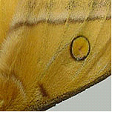
The mature larva is up to 100mm long and is bright green with a yellow stripe on either side of its body. Each segment of the body has 6 fleshy, yellow or purple-blue and or red tubercule (protuberances) with several spiky yellowish hairs.
The larva has chewing mouth parts and the adult moth dose not feed.
The pupa is inside a fibrous spherical cocoon that is brown with a hard texture and is up to 25mm long and attached firmly to the host plant on the twigs or small branches.
This insect has a Holometabolous life cycle, ie. When metamorphosis is observed during the pupal stage.

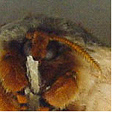 Large antennae
Large antennae
Appearance and Distribution of the Pest
The larvae are seen hanging in the host plant and pupate during early summer. It is distributed in sub tropical to temperate climates along the east coast of Australia from Queensland to Tasmania and can be an interesting subject in the garden.
Period of Activity
The larvae are active from late winter to early summer.
Damage Caused
The larvae chew leaves leaving large sections missing or reduce the leaf to only the mid rib. Normally not affecting the plant, and only causing problems when large numbers of larvae infest the host.
Susceptible Plants
There are a wide range of host plants which include, Eucalyptus species, Lophostemon confertus, Schinus areira, Betula pendula, Liquidambar styraciflua and Pinus radiata
Cultural Control
The larvae can be removed by hand and transferred to another host plant or squashed under foot.
Biological Control
Birds commonly eat the larvae, which reduces the numbers significantly.
Chemical Control
Chemicals may be used but normally unwarranted as the damage is not significant.
Note
Always read the label for registration details and direction of use prior to application of any chemicals.
DISEASE
NAME
Canker (General)
Various Canker Species
Description
This is a fungal problem that enters the plant through wounds causing dieback of twigs and stems.
Symptoms
The stems become discoloured (pale brown) usually from a pruned point, working its way down the stem and normally intersecting or surrounded with live cambium. The bark splits or cracks, foliage dies and infected areas can develop tiny black fruiting bodies. Heavy infected plants eventually die, though certain varieties are resistant halting the spread of the infection.

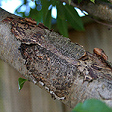
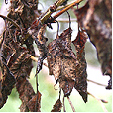
Black Canker (Phyaslospora miyabeana) forms dark brown spots with concentric rings on the upper leaf surface and grey spots on the stems. The tiny black fruiting bodies develop in the stem lesions. It is found on Salix species and persistent attacks will kill the tree.
The Canker (Cytospora valsa) causes the browning and death of branches in Picea abies and Picea pungens. This infection occurs normally from the base of the tree with infected needles falling, and white resinous patches appearing on the bark accompanied by cankers with tiny black fruiting bodies.
The Canker (Corynneum cardinale) is a casual fungus that invades wounds and infects living bark and associated cambium turning the foliage yellowish. As it spreads it girdles the branch killing it and ultimately the top of the tree dies out. Cankers eventually form in the trunk and ooze resin. It is found on Cypress.
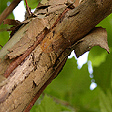 Platanus x hybrida
Platanus x hybrida
Cankerstain (Ceratocystis fimbriata f. platani) forms sunken cankers on the trunk and large limbs forming longitudinal cracks and roughened bark. Infected areas form callus around the margins which dies off and when cut open, dark coloured streaks are revealed extending to the central pith. These streaks then radiate out into uninfected wood resulting in the thinning of the crown and producing unusual small leaves. It is normally transmitted through poor tree surgery techniques and infected tools.
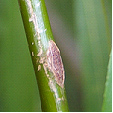 Cytospora Canker
Cytospora Canker
Cytospora Canker (Cytospora chrysosperma) is a casual fungus that infects the young twigs, then moving to the stems, branches and trunk causing brown sunken areas to appear that is covered in red pustules. The fungus tends to attack trees that are in poor health. Control requires the removal of infected branches and improved culture to regain the plants vigour. Sorbus aucuparia, Salix and Popular species are susceptible.
 Cypress Canker
Cypress Canker
Cypress Canker (Seiridium species) enters the plant through wounds or through insect damage causes the bark to spread revealing brown powdery spores that are accompanied by oozing resin. The canker eventually girdles the branch or trunk causing ringbarking and the death of the plant.
Nectria Canker (Nectria Cinnabarina) forms cankers on the twigs and small branches producing red fruiting bodies and eventually killing the tree. It is found in many parts of the world infecting a range of trees including hardwoods.
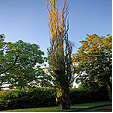
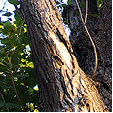
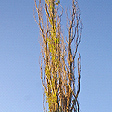 Populus nigra
Populus nigra
Poplar Canker (Cryptodiaporthe populea) infects the cambium layer damaging the bark and sapwood where the elongated sunken canker forms. Branches are girdled causing the upper portion to die off. This is a serious problem for Populus nigra var. Italica entering the plant through wounds or the leaves then spreading to twigs and branches. Control is difficult as removal of infected parts will not eradicate the problem, but encourage it. Young plants may be sprayed with a copper based fungicide to reduce leaf infection and heavily infected plants should be removed the burnt.
Stem Canker of Red Flowering Gum (Sporotrichum destructor) enters through wounds in the bark forming cankers in the trunk and branches, splitting the bark apart, revealing the wood and infesting the surface with powdery spores. This infection causes the leaves to wither and then the branches die, eventually killing the tree.
Stem Canker (Strumella coryneoidea) is a casual fungus that forms on the trunks of trees as a smooth, dispersed or sunken infection. On mature trees the infection sheds the bark with the canker forming callus tissue around the margins and the centre being exposed. These cankers then tend to extend up and down the trunk, only girdling over a long period of time. It is found on Quercus, Fagus, Aesculus species, and Acer rubrum , Nyssa sylvatica, Carya ovata and Morinda citrifolia.
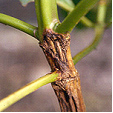
Source and Dispersal
The spores are found on infected dead plant material and can be dispersed by wind and with splashing water.
Favoured Conditions
It prefers a warm humid conditions and plants that have a wounds derived from poor pruning techniques and insect or other damage, especially if water is allowed to settle on the wound.
Affected Plants
Cankers may infect a wide range of trees and shrubs with some species being specific to its host. Examples are listed below.
Abies species are infected by several cankers including (Cytospora pinastri), (Cryptosporium macrospermum) and (Scoleconectria balsamea). These fungi form dead sunken areas on the trunk and branches.
Alnus species are infected by a few cankers including (Nectria coccinea) and (Physalospora obtusa) these attack the branches causing die back.
Betula species may be infected by the Canker (Nectria galligena) that occurs in the forks of trees causing splitting and cracking of the bark by swelling, to reveal the canker. Callus rings may form around the affected areas as a defence mechanism triggered by the tree.
Buxus species are infected by the Canker (Pseudonectria rousseliana) which shows signs of poor new growth during spring with the leaves turning from light green to a tan colour. These leaves tend to lay flat along the stems and reddish pustules appear both on the stems and leaves. The bark becomes loose and on inspection reveals a darkish colour underneath. It is difficult to control and the canker can kill the plant.
Castanea species are infected by the Twig Canker (Cryptodiaporthe castanea), a fungal problem that causes significant damage to the twigs and small branches, but tends to attack stressed trees.
Cercis and Ribes species are infected by the Canker (Botryosphaeria ribis) which forms small sunken areas on the stems causing wilting and eventually killing the branch by girdling. The cankers turn the bark black then split it open and the adjoining wood becomes discoloured. This is a serious problem for this and many other plant species.
Cotoneaster, Betula, Catalpa and Aesculus species are infected by the canker (Physalospora obtusa).
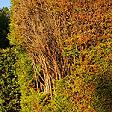
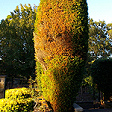 Cypress Canker
Cypress Canker
Cupressus species and Chamaecyparis lawsoniana are susceptible to Cypress Canker (Seiridium species) which causes leaf browning and then girdles the trunks resulting in ringbark. There is also another Canker (Coryneum cardinale) that has simular characteristics and is found in the northern hemisphere.
Cupressus sempervirens is infected by Cytospora Canker (Cytospora cenisia var. littoralis).
Larix species are susceptible to several fungal cankers including (Trichoscyphella wilkommii), (Trichoscyphella ellisiana), (Aleurodiscus amorphus), (Leucostoma Kunzei) and (Phomopsis spp.)
Nyssa sylvatica is attacked by three cankers including (Strumella coryneoidea).
Pinus species are infected by many types of cankers.
Platanus species are infected by Cankerstain.
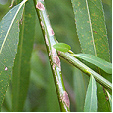 Cytospora Canker on Salix babylonica
Cytospora Canker on Salix babylonica
Pseudotsuga menziesii Douglas Fir is attacked by several cankers including (Cytospora species), (Dasyscypha ellisiana), (Dasyscypha pseudotsugae), (Phacidiopycnis pseudotsugae) and (Phomopsis lokoyae). These infections normally do not require control and are more prevalent on the coastal form.
Salix and Populus species are infected by several cankers including Cytospora Canker (Cytospora chrysosperma), Hypoxylon Canker (Hypoxylon pruinatum), Septoria Canker (Mycosphaerella populorum) and Branch Gall (Macrophoma tumefaciens). Many of these fungi can cause the death of the plant.
Thuja orientalis, Cupressus and Juniperus species are infected by the canker (Corynneum cardinale).
Tilia and Acer species are infected by (Nectria cinnabarina) attacking twigs or branches.
Tsuga species are infected by several cankers including (Dermatea balsamea) and ( Cytospora species).
Ulmus species are infected with up to eight fungal cankers including (Apioporthe apiospora) and (Nectria coccinea).
Vaccinium ovatum is infected by the canker (Coryneum microstictum) which attacks the stems.
Vinca species are infected by canker-dieback (Phomopsis livella) causing the shoots to wilt, turn brown and die. This can reduce the plant to ground level, and normally occurs during rainy periods.
Non-chemical Control
It is very difficult to control and correct pruning techniques with sharp tools for repairing wounds or prune well below the infected areas. Ensure that there are no ragged edges on the cuts and the angle should cut allows water to run off or dress the wound. Plant resistant varieties when available. Heavily infected trees should be removed to avoid spreading the disease.
Improve the culture of the affected plant to increase vigour for greater resistance.
Chemical Control
There is no satisfactory chemical control and prevention is imperative.
Note
Always read the label for registration details and direction of use prior to application of any chemicals.
Average Lowest Temperature : -3º C 27º F
USDA : 9, 10, 111
This USDA (United States Department of Agriculture) hardiness zone chart can be used to indicate a plant’s ability to withstand average minimum temperatures. However, other factors such as soil type, pH, and moisture, drainage, humidity and exposure to sun and wind will also have a direct effect on your plant’s survival. Use this chart only as a guide, always keep the other factors in mind when deciding where, when and what to plant.
A plant's individual USDA zone can be found in the Plant Overview.
Region of origin

South America, (Southern & Western)
Climate Description
Warm Temperate
This zone has the majority of rain during winter in the west and summer in the east with high humidity. Summer temperatures may peak at 40ºC (104ºF).
Frost and drought mainly occur inland and coastal wind is normally accompanied with rain.
Plant growth
Wide range of native and exotic plants grow well.
| Dictionary | Growth Habit |
| Leaf Type | Botanic Flower Description |
| Leaf Shape | Flower Inflorescence |
| Leaf Arrangement | Fruit Type |
| Leaf Margin | Bark Type |
| Leaf Apex And Bases | Flower Description |